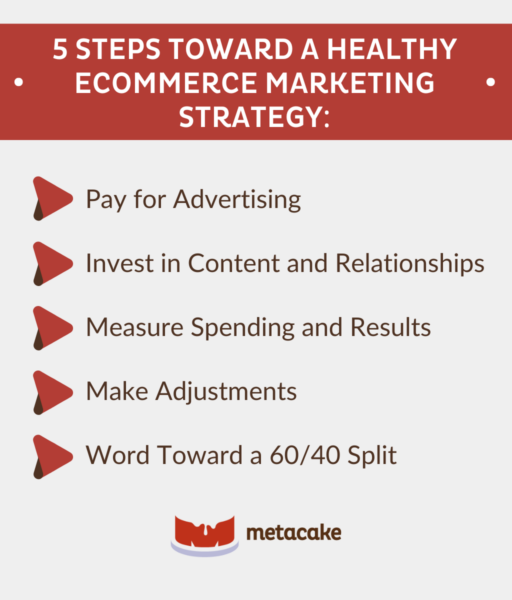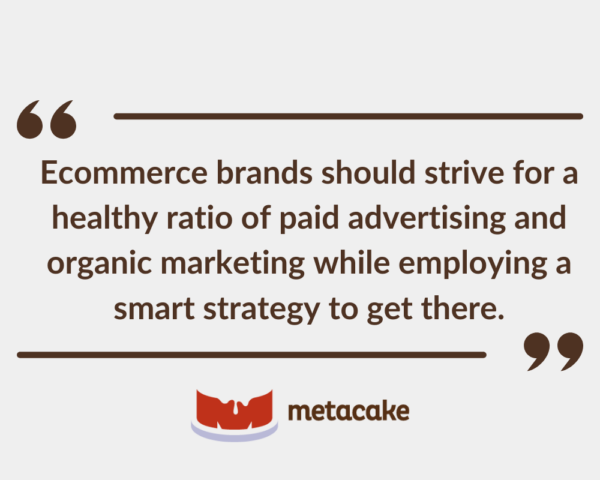We’ve previously discussed the value of growth marketing for ecommerce brands and what ecommerce business owners need to know about it. Today we’ll focus on one crucial aspect of growth marketing: paid advertising.
When using the term “paid,” it’s important to note that all advertising costs money. But when we talk about paid advertising, we’re talking about advertising efforts that require you to pay specifically for the placement of your ads. The most common examples are social media and Google search ads.
Other marketing initiatives, often referred to as organic marketing, still require investment. But it’s an investment of time and resources to produce the materials rather than paying for ad placements. This includes email marketing, social media, SEO work, and much more.
In this article, we’ll discuss what paid advertising for ecommerce is, where it fits into the overall marketing strategy, various forms of paid advertising, and five steps for implementing a proper paid strategy as part of a healthy marketing plan.
Paid Advertising Begins With the Customer Journey
It can be tempting to compartmentalize each of your paid marketing channels into buckets and zero in on one channel at a time. However, we don’t recommend thinking about each channel in isolation.
Each channel requires its own strategy based on its purpose and capabilities, but it still needs to fit into the bigger picture of the customer journey.
We often see ecommerce business owners and even marketing teams get caught up in attribution for each specific channel and hung up on whether they’re hitting a target ROAS for each. If that’s you, it’s important to understand that it’s not every channel’s job to win conversions or even clicks.
All channels work together to promote awareness of your brand and product, educate customers about it, drive them to your site (multiple times!), and eventually convert them.
It typically takes several touchpoints before that purchase happens. So, if you judge the success of all paid channels solely on ROAS and how quickly you see purchases rolling in, your marketing strategy will likely fail.
Where Does Paid Advertising Fit in the Overall Marketing Plan?
Paid advertising should be used to attract new customers to your ecosystem. The idea is to bring people into your world in a way that you can control.
You’re in charge of targeting the type of person you want to bring in; you set the ads’ creative messaging, and you guide the traffic to a designated landing page.
But if you want to build a healthy ecommerce business, those efforts should be coupled with ongoing organic marketing efforts, which we’ll explain below.
The Balance of Paid and Organic Marketing Efforts
The benefit of paid direct-response marketing (any ads with the goal of getting the customer to take immediate action) is that you can control new customer acquisition efforts directly. The more traffic you pay for, ideally, the more traffic you’ll get.
However, the downside is that if you stop paying for ads (or if an ad account gets shut down or an algorithm changes), you’ll stop getting customers. For that reason, it’s extremely important to turn the customers you acquire into lifetime fans who buy again and again. This helps your marketing dollars go further and helps protect against potential disruptions.
Meanwhile, you must be investing in organic marketing efforts such as content on your site, organic social media, relationships with affiliates and influencers, referral programs, and more. These can have a significant impact on your business, but they require more time to take effect.
Think of this dual-sided strategy as a two-stage rocket. When you get started in the early stages of marketing, your paid advertising will likely make up 90% of the overall strategy. It’s expensive, but it’s what gets you customers.
As you grow, the goal is to dial that paid advertising back to 50% or less of your overall marketing plan. But the only way to do that is if you’re investing in your non-paid marketing efforts, which will serve as your second-stage rocket.
With this approach, you’ll eventually get to the place where most of your new customers come from referrals, word of mouth, and general brand awareness rather than solely relying on paid ads.
The Different Types of Paid Advertising
So, what exactly does paid advertising include? Let’s walk through the different types of paid advertising and how they contribute to the overall strategy.
We like to break down the types of paid advertising into three categories based on how they reach potential customers.
1. Interruption-Based Advertising
- Social media advertising: Ads on Facebook, Instagram, and TikTok, which are usually images or short videos with corresponding captions and CTAs. They interrupt users as they’re exploring the platform, but if they’re done well, they’ll attract attention rather than look like a typical ad.
- Video advertising: Or as we all used to call it, “commercials.” These days, longer-form video ads can be placed on YouTube, streaming services, and, of course, traditional TV.
- Other advertising: Billboards, magazines, radio, podcasts, or display ads on search networks.
2. Intent-Based Advertising
- Search engine marketing: Also called “paid search ads,” are ads that appear in Google, Bing, or other search engines. These are intent-based because they appear in response to a user searching with the intention to find a solution to a question or problem.
3. Relationship-Based Advertising
- Affiliates and influencers: With this type of marketing, you are leveraging and paying for a relationship rather than the direct placement of the ad. Whether your affiliates are retail stores or popular bloggers, these are great ways to get exposure and increase traffic. And with the rise of social selling, influencer relationships are becoming increasingly helpful as well.

5 Steps Toward a Healthy Ecommerce Marketing Strategy
Now that we have a foundational understanding of paid advertising, let’s map out how it fits into a healthy ecommerce marketing strategy.
1. Pay for Advertising
To begin, we recommend investing about 80% of your marketing budget in paid digital advertising to drive traffic and acquire customers. This would primarily include paid social media ads (Facebook and Instagram, including TikTok if your audience is there) and paid search.
While doing so, it’s critical to have a strategy in place to increase the lifetime value of the new customers you’re acquiring. Use email marketing campaigns and automations to nurture visitors and customers, educate them about your brand and products, assist them with their purchases, and follow up with other products they might be interested in.
This, combined with having a great warranty or guarantee, helpful content, and outstanding customer service, will help convert these customers into fans of your brand.
2. Invest in Content and Relationships
Invest the remaining 20% of your budget in non-paid, long-term advertising. This includes content on your site and in emails, SEO work, non-product pages that build your brand, and affiliate relationships.
To execute this effectively, you’ll need a well-defined brand story and (likely) specialists in each of these areas. Remember that you may not get an immediate return on these investments. Maintain consistency and commitment to playing the long game.
3. Measure Spending and Results
Measure the balance of paid advertising and organic marketing monthly, quarterly, and yearly. Make sure this split is moving in the right direction and not relying too heavily on paid efforts for too long.
Of course, you’ll also need to monitor campaign results. The specialist in charge of each channel can be responsible for the detailed reporting of campaigns. However, as a business owner, you should have a high-level grasp of how much money is being spent on marketing and what kind of revenue it generates.
In fact, paying attention to this big-picture ratio of total spend to total revenue is often more efficient and effective than getting deep into the weeds about attribution and ROAS.
4. Make Adjustments
As you see organic marketing gain traction and movement, increase the budget you have to invest in these efforts. This doesn’t mean you should decrease your paid advertising spend just yet. This early momentum should allow you to spend more on organic marketing while also maintaining your paid advertising expenditure.
5. Work Toward a 60/40 Split
While you continue to invest in organic marketing and fine-tune your paid efforts, your aim is to achieve a split of at least 60% organic marketing and 40% paid advertising. Not many businesses are in this situation, so if yours can get there, you’ll be in a very strong position.
As we’ve discussed before, there is vulnerability in relying heavily on paid advertising. Shifting your weight toward organic marketing doesn’t eliminate risk entirely — for instance, there’s still some risk that comes with PR or SEO algorithms changing — but it does help provide stability.
Additionally, you always have the option to ramp up paid ad spending as needed. If you have product launches, promotional periods, or holidays you want to drive traffic for, you can increase spend with strategic campaigns.
Think of paid advertising as your nitro boost. You can use it to gain ground, but you’ll burn out if you let it fuel everything for the entire race.
Final Thoughts
Overall, ecommerce brands should strive for a healthy ratio of paid advertising and organic marketing while employing a smart strategy to get there.
As you measure your paid ad campaigns’ results, make sure you’re not solely looking at ROAS. Watch the lifetime value and average order value for your customers, and work on increasing them. Keep in mind the journey of the customer and how each channel contributes to increasing awareness, driving traffic to your site, and assisting with the sale.
Metacake can help if you’re struggling with the following:
- Determining what your paid marketing strategy should look like
- Becoming a healthier ecommerce brand
- Becoming more resilient against the ever-changing paid advertising landscape
Feel free to reach out to our award-winning team for more information on programs that’ll help lay the foundation for healthy growth in 90 days.

